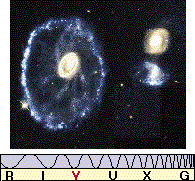| Contemplating the congested confines of a rich galaxy cluster (such as Virgo or Coma, with thousands of member galaxies orbiting within a region a few megaparsecs across), we might expect that collisions among galaxies would be common. Gas particles collide in our atmosphere, and hockey players collide in the rink—do galaxies in clusters collide too? The answer is yes.
This stunning image of three galaxies probably shows the aftermath of a bull's-eye collision of one of the two small galaxies at right (which one is still unknown) with the larger one at left. The result is the Cartwheel Galaxy, about 150 Mpc from Earth, its halo of young stars resembling a vast ripple in a pond. The ripple is most likely a density wave created by the passage of the smaller galaxy through the disk of the larger one (see Section 23.5). The resulting disturbance is now spreading outward from the impact region, creating new stars as it goes.
Whether some galaxies are genuinely colliding or only experiencing a close encounter cannot easily be determined. No human will ever witness an entire collision, for it would last many millions of years. However, computer simulations of these systems display formations remarkably similar to the real thing. The particular simulation shown began with two spiral galaxies, but the details of the original structure have been largely obliterated by the collision. Notice the similarity to the real image of NGC 4038/4039 (the black and white image), the so-called Antennae galaxies which show extended tails as well as double galactic centers only a few hundred parsecs across. Star formation induced by the collision is clearly traced by the blue light from thousands of young, hot stars evident in the high-resolution Hubble image at right. (The Hubble field of view is outlined on the black and white image). The simulations suggest that ultimately the two galaxies will merge into one.
Direct observational evidence now indicates that galaxies in clusters apparently collide quite often. In the smaller groups, the galaxies' speeds are low enough that interacting galaxies tend to "stick together," and mergers, as shown in the |
computer simulation, are a very common outcome. In larger groups, galaxies move faster and tend to pass through one another without sticking. Since the early 1980s it has become increasingly clear, on the basis of both observations and numerical simulations, that collisions can have very large effects on the galaxies involved. The stellar and interstellar contents of each galaxy are rearranged, and the merged interstellar matter very likely experiences shock waves that trigger widespread bursts of star formation (see also Figures 24.26 and 24.29). Some researchers go so far as to suggest that most galaxies have been strongly influenced by collisions, in many cases in the relatively recent past. Curiously, although a collision may wreak havoc on the large-scale structure of the galaxies involved, it has essentially no effect on the individual stars they contain. The stars within each galaxy just glide past one another. Although we have plenty of photographic evidence for galaxy collisions, no one has ever witnessed or photographed a collision between two stars. Stars do collide in other circumstances—in the dense central cores of galactic nuclei and globular clusters, or as a result of stellar evolution in binary systems—but stellar collisions are a very rare consequence of galaxy interactions. To understand why individual stars do not collide when galaxies collide, recall that the galaxies within a typical cluster are bunched together fairly tightly. The distance between adjacent galaxies in a given cluster averages a few hundred thousand parsecs, which is only about 10 times greater than the size of a typical galaxy. Galaxies simply do not have that much room to roam around without bumping into one another. By contrast, stars within a galaxy are spread out much more thinly. The average distance between stars within a galaxy is a few parsecs, which is millions of times greater than the size of a typical star. When two galaxies collide, the star population merely doubles for a time, and the stars continue to have so much space that they do not run into one another. The stellar and interstellar contents of each galaxy are certainly rearranged, and the resultant burst of star formation may indeed be spectacular from afar, but from the point of view of the stars, it's clear sailing. |
